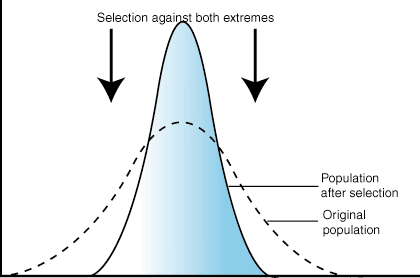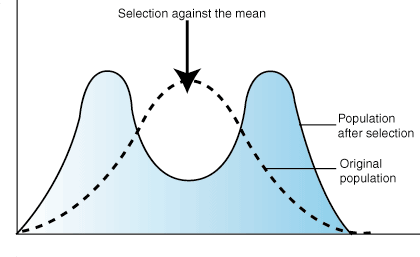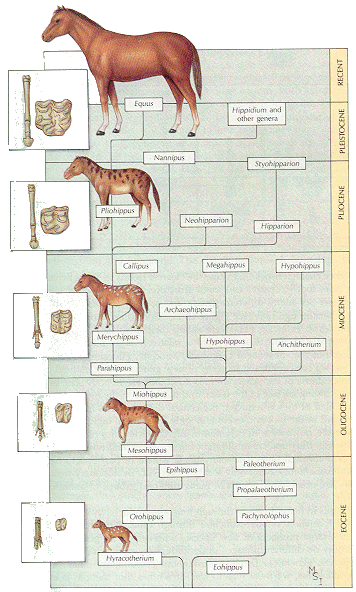Throughout Earth's history, there have been five major extinction events. Because of those events, many species either became endangered or extinct. But all of those events occurred due to a certain cause. There lately has been talk that humans may cause the next extinction event with pollution and such. I think it is completely possible that it could cause a major extinction event in the distant future with the effects of pollution. But that's not the only possibility, I think that another could also be caused by natural events such as major ocean level changes and asteroid impacts.
Wednesday, March 2, 2011
Friday, February 25, 2011
Blog #4: The Three Types of Selection
- Stabilizing Selection
- Stabilizing selection is when the selective pressures select against the two extremes of a trait. Because of that a population experiences stabilizing selection. An example of this can be seen in plants. For example, one plant may be too short too thrive while another may be too tall. When combined, these too plants maintain a medium height.
 |
| The effect of stabilizing selection on trait distribution. |
2. Directional Selection
- Directional selection is when one extreme of the trait distribution experiences selection against it. Because of this, the population's trait distribution shifts toward the other extreme. Examples can be seen in giraffe necks. Shorter necks can't reach certain leaves, so in response, distribution of neck length shifts to those with longer necks.
 |
| The effect of directional selection on trait distribution. |
3. Disruptive Selection
- Disruptive selection is when selection pressures act against those in the middle of the trait distribution. The result is a bimodal. An example can be seen in flowers. For example, one type of flower has variable heights and is pollinated by three different pollinators. One that prefers short plants, one that prefers medium plants, and one that prefers tall plants. If the medium sized height liking pollinator was to disappear from the area, the population would grow more short and tall plants.
 |
| The effect of disruptive selection on trait distribution. |
Thursday, February 17, 2011
Blog #3: What is Microevolution?
Microevolution is a change in gene frequency within a population. The four ways that that variation occurs are: selection, mutation, genetic drift, and gene flow.
Blog #2: Why are Fossil Records Hard to Interpret?
Fossil records can be hard to interpret because of the fact that they could be deteriorated to the point where they are un-examinable.
Thursday, February 3, 2011
Blog #1: Why is Evolution a Theory and not a Law?
In science a fact overwhelms a theory because a law is a widespread fact that has never ending evidence. A theory, on the other hand, is not exactly proven but is supported and believed my many scientists. Evolution is a theory because there is a bunch of evidence that supports it.
Thursday, January 13, 2011
Blog #14: Semester in Review
The first semester of my sophomore year has been a busy one. Even though it has been more fun than freshman year, especially Tri-City Orchestra, it has been a lot more stressful due to my effort in trying to keep all my straight A's well..... straight.A's. Biology, for one, has had its ups and downs. My favorite activities of the semester are those that had to do with microscopes. I liked it best because I thought it was fun and very interesting. My least favorite activity of the semester is the Wiki project that we are doing right now. It is my least favorite because of the fact that it's really hard and confusing. If I could change one thing to improve the next semester, I would want to not have a project that is really confusing and uses a method that none of has have ever had experience with, like the Wiki project.
Sunday, January 9, 2011
Blog #13: DNA and Crime investigation
DNA has changed how we investigate crimes in many ways. One way is that it helps clear people that have been wrongfully charged, of their charges, and throws the correct suspect in jail. Even decades later. It is way more precise than older methods. But unfortunately there has been such a huge pile up of cases over the years, that there are not enough forensic analyzers.
Two examples of tests are:
1. Salivary Tests
2. Blood Tests
Two examples of tests are:
1. Salivary Tests
Subscribe to:
Posts (Atom)





